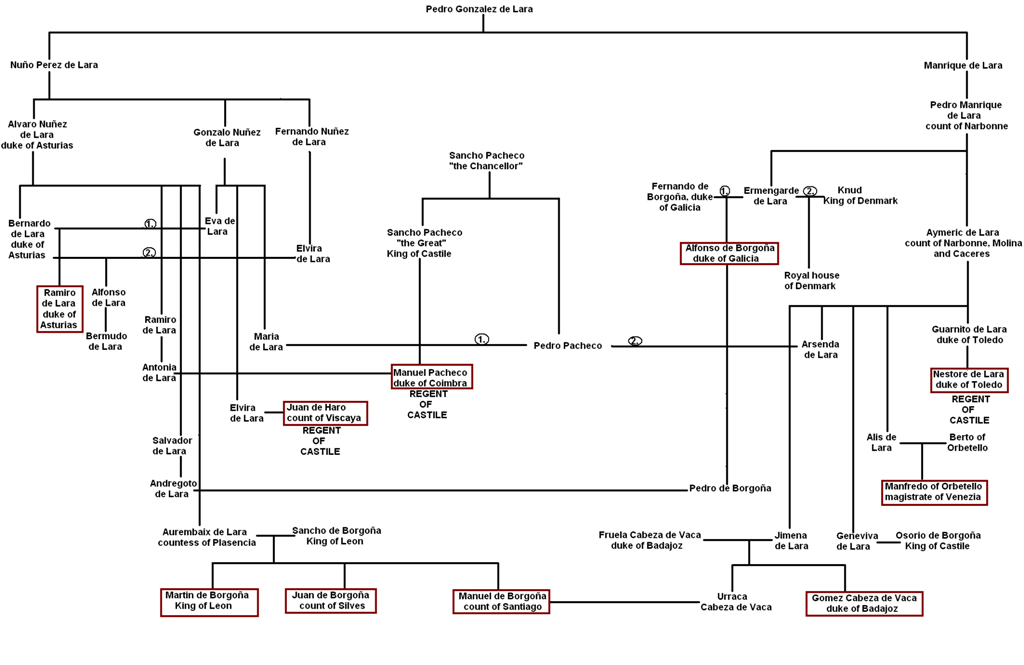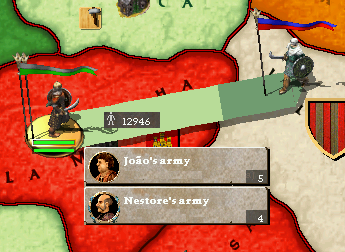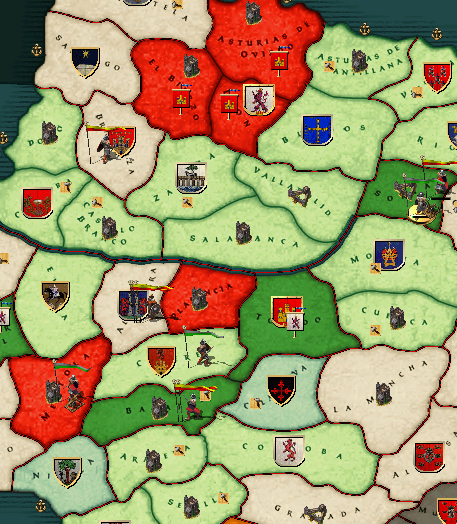The meeting of the six regents would be remembered as the “Compromise of Toledo”. In the name of the child king, the kingdom of Castile would be ripped apart by internal struggle. All the regents arrived in the capital with their own goals. Some desired a broader autonomy within the kingdom; others wanted nothing less than independence. The regents met on July 15th 1242, a mere week after the death of king Jose Pacheco. The council would last until August 7th, when a final decision would be reached and agreed upon by all participants.
The succession in Castile was first contested by the Governor of Tuscany, Urbano da Camino. He declared the Pacheco dynasty to be usurpers of the throne, and announced the de facto independence of the Tuscan republic. The governor then left the Council and with him disappeared the last Castilian aspirations to Italian supremacy. To avoid such future actions by the regents, the duke of Sevilla, Francisco de Borgoña took his eight thousand men army to Toledo and garrisoned it outside the city walls.
He refused to interfere in any way with the actual Council debates, but the rumors circulating were that he planned to claim his father’s throne and restore the Borgoña dynasty. In fact, no other regent brought his host to Toledo, as they hurried to the capital with only their personal guard, not wanting to miss out on their share of the prey.
In their correspondence and in the unofficial documents of the council, discovered in the late 17th century, their defiance of the king goes so far as to call him “the count of Porto” and not recognize him as their liege. The only voice of reason, or more probably of the duke of Sevilla, was bishop Joao de Borgoña. While the reduction of the Royal Demesne was a given fact, he countered the initial proposals with arguments of common-sense.
Duke Nestore de Lara was adamant that the king is not of age to govern, and he should not be left with more than the city of Toledo under direct Royal administration. This was also the point of view expressed by the count of Viscaya, Juan de Haro. De Haro was a pawn of the de Laras, being promised the duchy of Navarra in exchange for his support in the council. This, later called by the historians a “typical de Lara Visigothic attitude”, was part of the de Laras’ generations-old plan to revive the ancient Kingdom of Pamplona. Through his wife, count de Haro was deep under the de Lara family’s influence. The count of Viscaya and the duke of Toledo stood together behind their decision: the king should be left with the city of Toledo only, and the Fernando Lainez was to be the king’s regent. The northern regions would receive a Viceroy – the inbred, retarded duke of Asturias, Ramiro de Lara. This was the de Lara plan.
Bishop Joao de Borgoña countered the de Lara plan with a proposal for the conservation of the status quo. Although such a measure would never pass, he hoped his extreme suggestion would lead to some concessions from “the Northerners”. He did not have a strong political position to impose his point of view, but the arrival of the Sevillan armies of his second-cousin added a lot of extra weight to his voice.
Duke Manuel Pacheco of Coimbra, as the king’s closest relative, was the supporter of reducing the Royal Demesne, but not reducing the King’s authority, since he was the heir presumptive to the throne. His suggestion was merging the Northern lands under the rule of a de Lara duke , while the duchy of Coimbra would be enlarged with all the Portuguese Crown fiefs: Porto, Alcacer do Sal and Evora. His plan was strongly opposed by the count of Viscaya, who did not look forward to becoming a legal vassal of the de Laras, and by bishop Joao.
Fernando Lainez, king Jose’s advisor, was legally the strongest, since the king’s last testament declared him sole official regent during King Raimundo’s minority. But in fact, his position could change in favor of whoever promised him a landed nobility title.
The council went on for almost a month, neither one of the regents daring to threaten with leaving the kingdom, not to anger the duke of Sevilla, who took upon himself the title of “moderator” of the Council. It was the duke’s proposal that everyone finally agreed upon, more or less reluctantly. It would be a compromise that pleased everybody and nobody at the same time. Duke Francisco stated that he and his soldiers would in no way accept that the Royal Demesne be reduced to a smaller territory than the kingdom’s most powerful Duchy. While everyone saw this as a desire to maintain the king as more powerful than any of his vassals, none of the regents realized that the Duchy of Sevilla was the largest. Duke Francisco’s second demand was that elective law be re-instated, and this gave the Dukes an illusion of power, in view of their territorial gains made during the council. Since the enlargement or reduction of the Duchy of Sevilla never did come up, as the Duke was not a regent, the five regents missed the fact that after the re-instatement of the new law, the legal heir would be Duke Francisco de Borgoña himself.
Everyone left the council convinced of their victory. And in spite of the duke of Sevilla’s efforts, the kingdom was indeed torn to pieces:








